
The Siegfried Line, known in German as the Westwall, was a German defensive line built during the late 1930s. Started in 1936, opposite the French Maginot Line, it stretched more than 630 km (390 mi) from Kleve on the border with the Netherlands, along the western border of Nazi Germany, to the town of Weil am Rhein on the border with Switzerland. The line featured more than 18,000 bunkers, tunnels and tank traps.

Pirmasens is an independent town in Rhineland-Palatinate, Germany, near the border with France. It was famous for the manufacture of shoes. The surrounding rural district was called Landkreis Pirmasens from 1818 until 1997, when it was renamed to Südwestpfalz.
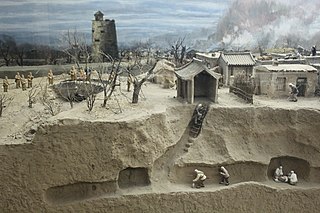
Tunnel warfare is using tunnels and other underground cavities in war. It often includes the construction of underground facilities in order to attack or defend, and the use of existing natural caves and artificial underground facilities for military purposes. Tunnels can be used to undermine fortifications and slip into enemy territory for a surprise attack, while it can strengthen a defense by creating the possibility of ambush, counterattack and the ability to transfer troops from one portion of the battleground to another unseen and protected. Also, tunnels can serve as shelter from enemy attack.
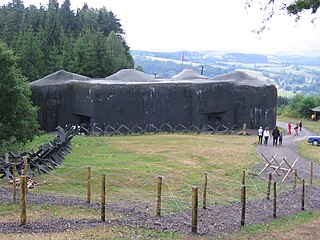
Czechoslovakia built a system of border fortifications as well as some fortified defensive lines inland, from 1935 to 1938 as a defensive countermeasure against the rising threat of Nazi Germany. The objective of the fortifications was to prevent the taking of key areas by an enemy—not only Germany but also Hungary and Poland—by means of a sudden attack before the mobilization of the Czechoslovak Army could be completed, and to enable effective defense until allies—Britain and France, and possibly the Soviet Union—could help.

Ouvrage Rochonvillers is one of the largest of the Maginot Line fortifications. Located above the town of Rochonvillers in the French region of Lorraine, the gros ouvrage or large work was fully equipped and occupied in 1935 as part of the Fortified Sector of Thionville in the Moselle. It is located between the petit ouvrage d'Aumetz and the gros ouvrage Molvange, facing the border between Luxembourg and France with nine combat blocks. Rochonvillers saw little action during World War II, but due to its size it was repaired and retained in service after the war. During the Cold War it found a new use as a hardened military command centre, first for NATO and then for the French Army.

Ouvrage Fermont is a gros ouvrage of the Maginot Line, part of the Fortified Sector of the Crusnes in northeastern France, near the community of Montigny-sur-Chiers. It is located near the commune of Montigny-sur-Chiers, between the petit ouvrage Ferme Chappy and the gros ouvrage Latiremont. The position is near the western end of the Line, about four kilometers east of Longuyon, facing Belgium. There was significant combat at Fermont during the last stages of the Battle of France. It was repaired and reactivated during the 1950s and 1960s as a strongpoint in the event of an invasion by Soviet forces. After being abandoned by the military, it has been restored and is maintained as a museum.

Ouvrage Boussois is a petit ouvrage of the Maginot Line, built as part of the "New Fronts" program to address shortcomings in the Line's coverage of the border with Belgium. Like the other three ouvrages near Maubeuge, it is built on an old Séré de Rivières fortification, near the town of Boussois. The fortification surrendered to the Germans twice, in the First World War on 6 September 1914, and in the Second World War on 22 May 1940. The site is now abandoned.

Ouvrage Sapey is a work of the Maginot Line's Alpine extension, the Alpine Line, also known as the Little Maginot Line. The ouvrage consists of one entry block, three artillery blocks and one observation block two kilometers west of Modane. The ouvrage was built beneath the older Fort du Sapey. The new work cost 12.8 million francs.

The Queich is a tributary of the Rhine, which rises in the southern part of the Palatinate Forest, and flows through the Upper Rhine valley to its confluence with the Rhine in Germersheim. It is 52 kilometres (32 mi) long and is one of the four major drainage systems of the Palatinate Forest along with the Speyerbach, Lauter and Schwarzbach. The Queich flows through the towns Hauenstein, Annweiler am Trifels, Siebeldingen, Landau, Offenbach an der Queich and Germersheim.
Husterhoeh Kaserne was a military facility in Pirmasens, Rhineland-Palatinate, Germany. Kaserne is a German loanword that means "barracks." It was a United States military base 1945–1994. Since then it is a German base, most of which has closed. The base still has some US military operations and German military storage.
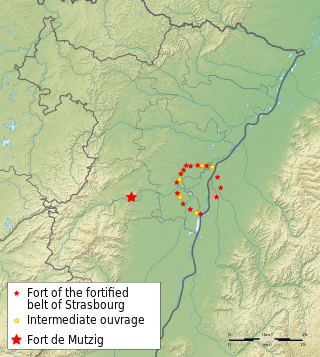
The Fort de Mutzig, also known as Feste Kaiser Wilhelm II, is located near the town of Mutzig, in the Bas-Rhin department of France. It is one of the fortifications built by Germany at the end of the 19th century to defend Strasbourg.
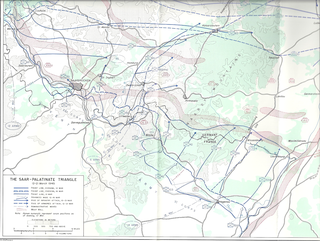
Operation Undertone, also known as the Saar-Palatinate Offensive, was a large assault by the U.S. Seventh, Third, and French First Armies of the Sixth and Twelfth Army Groups as part of the Allied invasion of Germany in March 1945 during World War II.

Fort Reuenthal is a 20th-century Swiss fortification located in the Aargau canton near the Swiss border with Germany. Built between 1937 and 1939, the fort overlooks the Rhine where it bends around the town of Full-Reuenthal, and was intended to prevent a crossing of the Rhine at the hydroelectric plant at Dogern. It was a component of the Swiss Border Line of defenses. It is armed with two artillery blocks for 75 mm guns and two machine gun blocks. The fort uses camouflage, with house-like superstructures over some positions. Deactivated as a military post in 1988, it is operated as a museum.
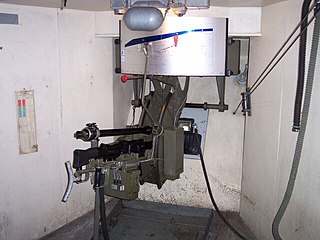
Fort Heldsberg was built 1938–1940 near St. Margrethen in Switzerland, overlooking the Rhine, which forms the Swiss-Austrian border at that location, just south of Lake Constance. The fort was part of the Swiss Border Line defenses, built between 1938 and 1941.
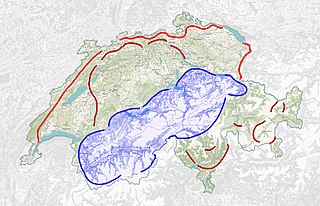
The Swiss National Redoubt is a defensive plan developed by the Swiss government beginning in the 1880s to respond to foreign invasion. In the opening years of the Second World War the plan was expanded and refined to deal with a potential German invasion. The term "National Redoubt" primarily refers to the fortifications begun in the 1880s that secured the mountainous central part of Switzerland, providing a defended refuge for a retreating Swiss Army.

Vladivostok Fortress is a system of fortifications built from 1889 to 1918 in Vladivostok, Russia, and the surrounding area.
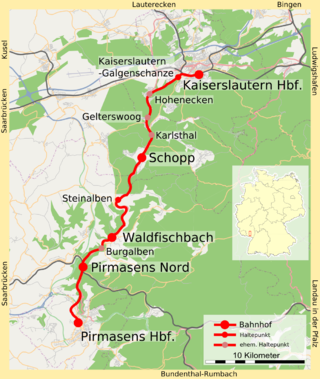
The Biebermühl Railway —sometimes called the Moosalbbahn —is a 35.9 km long railway line from Kaiserslautern to Pirmasens in the German state of Rhineland-Palatinate, which was built between 1875 and 1913. The first section between Biebermühle and Pirmasens connected the city of Pirmasens to the railway network, which could only be achieved via a branch line due to the topography. In 1905, another branch was opened from Biebermühl to Waldfischbach, which was extended in 1913 to Kaiserslautern. It was subsequently used by long-distance services, which operated until 1990. Since then, it has been used only by local services. It is the only one of all the Palatine railway lines that were completed in the 20th century that have never been threatened with closure.

The Regelbau were a series of standardised bunker designs built in large numbers by the Germans in the Siegfried Line and the Atlantic Wall as part of their defensive fortifications prior to and during the Second World War.
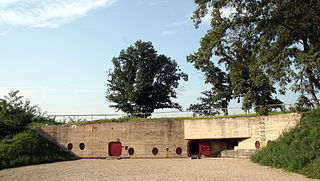
The B-Werk near Besseringen is the only completely preserved fortification built to construction standard "B" in the Siegfried Line. It is part of the so-called Saar position and lies within the borough of the German town of Merzig.


















